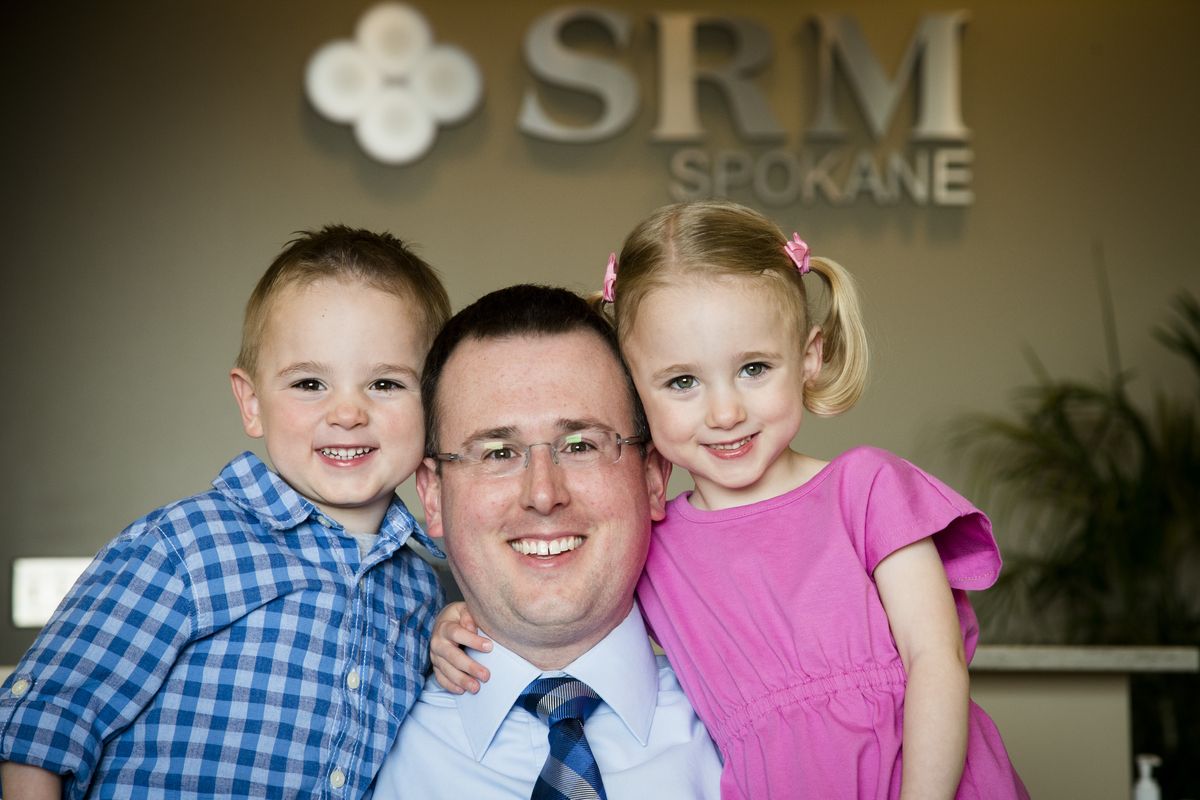‘We hit the jackpot’
Spokane fertility doctor and his wife needed to lean on his expertise to finally become parents

Tom Fisher, a fertility doctor in Spokane, needed some of his own medicine for him and his wife to become parents.
On this Father’s Day, Fisher is spending time with his 4-year-old twins and awaiting the birth of a new daughter, due in July. Tom and Lisa Fisher likely wouldn’t have become parents without in vitro fertilization treatments, one of the therapies Fisher oversees at SRM Spokane, operated by Seattle Reproductive Medicine. It’s the second reproductive medicine clinic in Spokane. (The Center for Reproductive Health is the other.)
While giving a tour of his Indiana Avenue office, Henry and Grace in tow, he proudly shows the twins’ first picture – at 5 days old. The embryos look like tiny bubbles. Grace points to her photo and knows she was already hatching, unlike Henry. The two giggle, not grasping the significance of their embryo photos. Shortly after the photo was taken, the embryos were transplanted into Lisa’s uterus. Nine days later a pregnancy test confirmed her pregnancy.
“It was exhilarating,” Lisa Fisher said. “Finally, after so much drama and stress. But then you start to worry if you can stay pregnant.”
IVF increases the risk of pre-term births and low birth rates. Tom Fisher said the treatments aren’t the risk but instead the very fact that the woman needed the treatment. All went well until the pregnancy’s midway point. Lisa endured weeks of hospital bed rest until the twins delivered at 27 weeks, each weighing 2 pounds, 5 ounces. Henry spent 11 weeks in NICU; Grace was there 10 weeks.
Tom Fisher said it was difficult having his children as patients – they were born at the Portland hospital where he was doing is OB-GYN residency.
“You just know too much,” he said. “The nurses kept telling me just to relax; that I needed to calm down.”
So far, this new pregnancy – which started with a frozen fertilized embryo saved from the initial 2010 collection – isn’t as dramatic. Yet the Fishers remain somewhat nervous, like any parent who has experienced a high-risk pregnancy. They are just glad Lisa has made it past the 25-week mark.
When couples seek Fisher’s help in becoming pregnant, usually they have no idea their doctor and his wife shared similar struggles. Fisher doesn’t advertise the fact. His office is plain and conservative, with a few chairs and some brochures. He does have a family photo, but it’s small, pushed to the far corner of his desk.
Fisher doesn’t talk about his own struggle with fertility unless he thinks it might help give understanding and compassion to often difficult situations.
“I don’t think it’s appropriate to bring up to everyone,” he said. “But when I do I tell them I truly understand – not as a physician but as a previous patient. I do think people relax a little more.”
By the time couples come to Fisher, who started at SRM in August, they have already been trying to conceive for at least a year, so there is a lot of stress and frustration.
There are 6.7 million women – about 12 percent – in the United States, ages 15-44, who have an impaired ability to get pregnant or carry a baby to term, according to the Centers for Disease Control and Prevention.
Both men and women contribute to infertility. About 7.5 percent of all sexually experienced men younger than age 45 reported seeing a fertility doctor, which equals 3.3 million to 4.7 million men, according to a CDC study that analyzed data from the 2002 National Survey of Family Growth. About 18 percent of these men were diagnosed with a male-related infertility problem.
Infertility can have a variety of causes with a wide range of treatments, from medicine, surgery, intra-uterine insemination or assisted reproductive technology in which both the egg and sperm are handled outside the body. In vitro fertilization is the most common means of fertilization outside the body.
“About 60 to 70 percent of what I do is counseling,” Fisher said. He added that medical students don’t get extensive teaching in fertility while in school.
The same is true for miscarriages, in which couples often suffer in isolation. Fisher doesn’t classify reproductive problems as a stigma, but instead thinks the topics are often too uncomfortable. It’s similar to how our culture doesn’t comfortably embrace death and illness.
Morgan Brooks, 27, had no idea her doctor and his wife had similar difficulties keeping pregnant. After three miscarriages, Brooks and her husband made an appointment with Fisher.
“He was so compassionate and understanding,” said Brooks, who after a few noninvasive drug treatments is pregnant with a baby boy due in August. “I’m glad we went to him when we did. We just didn’t know what to do.”
After a few appointments, Fisher shared his family’s infertility story with Brooks. She said his personal experience is likely why he’s such a empathetic doctor.
“We hit the jackpot,” she said. “We found somebody we absolutely loved. He made things seem so easy when all we had was hard, hard, hard.”